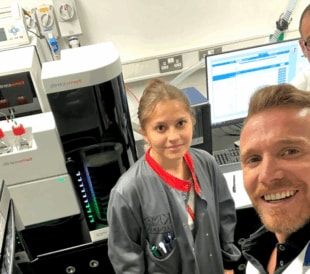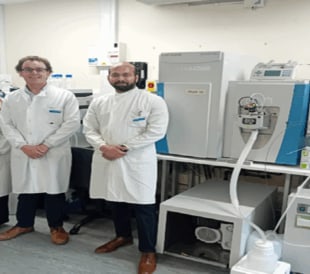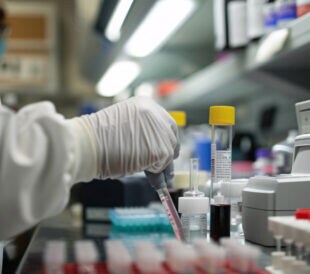Clinical research laboratories face many decision points in establishing routine analytical workflows for mass spectrometry. One decision is how to handle the complexity of biological matrices, both from a potential background interference that may diminish reproducible quantitation, as well as increased frequency for instrument maintenance. Should more effort be placed on extensive sample preparation steps as opposed to performing more invasive instrument maintenance? Sample preparation introduces costs associated with solvents, supplies, columns, technicians’/scientists’ time and expertise, and perhaps additional equipment for automation.
 Previously published workflows have utilized more extensive approaches to overcoming matrix issues. Incorporation of online sample cleanup has been demonstrated to improve robustness for ISD analysis in precipitated whole blood. The LC system method utilized a second UHPLC pump to drive the sample loading and cleanup as well as a trapping column that was replaced after 1,000 injections. Also, the two-minute total method used nearly 5 mL per sample analysis with almost 50% of the total solvent consisting of methanol.
Previously published workflows have utilized more extensive approaches to overcoming matrix issues. Incorporation of online sample cleanup has been demonstrated to improve robustness for ISD analysis in precipitated whole blood. The LC system method utilized a second UHPLC pump to drive the sample loading and cleanup as well as a trapping column that was replaced after 1,000 injections. Also, the two-minute total method used nearly 5 mL per sample analysis with almost 50% of the total solvent consisting of methanol.
Opting to forego more extensive sample preparation, laboratories can instead utilize six-port switching valves with increased frequency for instrument maintenance. Diverting the chromatographic eluent during the sample loading and washing keeps portions of unwanted matrix compounds away from the ion source and mass spectrometer. However, the eluent is switched back to the ion source during the analytical gradient, introducing background matrix compounds into the ion source and mass spectrometer that — over time and multiple injections — require instrument maintenance. Instrument maintenance may be as simple as removing the ion transfer tube for cleaning (taking minutes) or more involved, where one breaks the instrument vacuum to clean the API stack, which can take between three and 18 hours, depending on the mass spectrometer. Regardless of the instrument maintenance steps, data acquisition will be interrupted.
The Thermo Scientific™ FAIMS Pro Duo interface can remove this decision point, thus improving laboratory productivity while minimizing sample analysis costs. The interface utilizes high-field asymmetric waveform ion mobility to introduce orthogonal selectivity for target compounds relative to both liquid chromatography and mass spectrometry. In addition, the unique design of cylindrical electrodes used in the FAIMS Pro Duo interface not only increases ion transmission through the interface relative to planar electrode geometries, but introduces a physical barrier between the electrospray emitter tip and the entrance to the mass spectrometer.
 Figure 1. Diagram for the Thermo Scientific FAIMS Pro Duo interface relative to the ESI emitter tip and the entrance to Thermo Scientific mass spectrometers through the ion transfer tube.
Figure 1. Diagram for the Thermo Scientific FAIMS Pro Duo interface relative to the ESI emitter tip and the entrance to Thermo Scientific mass spectrometers through the ion transfer tube.
Ions are forced to move around the center electrode while neutrals are blocked, preventing them from entering the mass spectrometer. Optimizing the compensation voltage (CV) for target compound transmission can further improve selectivity and reproducibility while attenuating transmission for a larger percentage of unwanted, co-eluting matrix ions.
To evaluate the dual benefit introduced through the FAIMS Pro Duo interface, a comparative study was performed, measuring immunosuppressants spiked into whole human blood over the course of five days using a standard workflow without FAIMS selectivity and with the FAIMS Pro Duo interface. [Technical Note 000814]. On each of the five days, a total of 360 injections were performed per day for a total of 1,800 injections into the Thermo Scientific™ Orbitrap Exploris™ 240 mass spectrometer. A set of four immunosuppressants were spiked into the whole blood (with a 5:1 protein crash) to mimic routine sample analysis. Commercial calibrators were used to generate quantitation curves and QC samples. A fifth immunosuppressant, Ascomycin, was used as an internal standard and spiked into all samples at a constant amount.
The data collection of the calibration curves shows a linear relationship for results generated both with and without the FAIMS Pro Duo interface. The peak area response for Cyclosporin A has been normalized to Ascomycin and the linear response indicates that both experience similar matrix effects. It’s also apparent that there is a slightly attenuated response when utilizing the FAIMS Pro Duo interface, but sensitivity and reproducibility are still maintained across the calibration range. Also, comparing the peak area response ratios measured on days one and five using the experimental method with the FAIMS interface shows that the response remains consistent with the FAIMS Pro interface as opposed to using the standard method.
 Figure 2. Comparative quantitation curves for Cyclosporin A in crashed whole human blood. Peak area ratios were determined as normalized to the internal standard Ascomycin. Quantitation curves 2A and 2B were acquired without FAIMS selectivity on days 1 and 5, respectively, and curves 2C and 2D were acquired with FAIMS selectivity on days one and five.
Figure 2. Comparative quantitation curves for Cyclosporin A in crashed whole human blood. Peak area ratios were determined as normalized to the internal standard Ascomycin. Quantitation curves 2A and 2B were acquired without FAIMS selectivity on days 1 and 5, respectively, and curves 2C and 2D were acquired with FAIMS selectivity on days one and five.
While the normalized area response appears stable for both experimental methods, evaluation of the raw area measurements shows the improved robustness realized by adding in FAIMS selectivity. Figure 3 shows the measured area results with the trendlines for each ISD and data acquisition strategy. Two clear trends are evident: 1) introducing FAIMS selectivity maintains better intra-day reproducibility and 2) minimizes matrix effects which otherwise reduce the peak areas measured across the entire study.
Maintaining consistent area measurements is also critical, as deviations in ISD peak areas greater than 20% can surpass acceptance criteria for clinical research laboratories, reducing data confidence. For most situations, the instrument ion source region is cleaned and sample batches are re-analyzed, reducing productivity. Results obtained using the FAIMS Pro Duo interface show only a 3-4% loss in signal relative to the first day and the %CV is maintained around 5% throughout the week. Similar trends were measured for the additional three ISDs.
 Figure 3. Evaluation of the average Cyclosporin A peak area in human whole blood across the five-day study acquired using 3A the standard workflow and 3B with the FAIMS Pro Duo interface. The dashed lines represent the trend in measured peak areas across the five days. The values listed on the daily response for 3A and 3B represent the difference in average peak areas per day relative to that measured for day 1. Similar measurements were presented for the remaining three ISDs 3C using the standard workflow and 3D data acquisition with the FAIMS Pro Duo interface.
Figure 3. Evaluation of the average Cyclosporin A peak area in human whole blood across the five-day study acquired using 3A the standard workflow and 3B with the FAIMS Pro Duo interface. The dashed lines represent the trend in measured peak areas across the five days. The values listed on the daily response for 3A and 3B represent the difference in average peak areas per day relative to that measured for day 1. Similar measurements were presented for the remaining three ISDs 3C using the standard workflow and 3D data acquisition with the FAIMS Pro Duo interface.
The addition of the FAIMS Pro Duo interface to the LC-MS workflow demonstrated increased instrument robustness while maintaining selectivity to overcome the complex biological matrix. This solution simplifies the method development through well-defined CV optimization routines [Technical Note 000304] to both maximize target compound transmission into the mass spectrometer while suppressing unwanted ion transmission. Used in the LC-MS workflow, cleaning the FAIMS Pro Duo interface becomes ideal based on the following:
- Takes minutes to perform the simple maintenance
- Does not require mass spectrometer vacuum to be broken or recalibrated to restart data acquisition
- Requires a simple tool for removal at analytical LC flow rates
- Does not disrupt the Thermo Scientific™ OptaMax NG API source probe settings bypassing re-optimization
FAIMS selectivity has been demonstrated to improve selectivity for small molecules, peptides and proteins in workflows utilizing low- and high-flow chromatography. The presented method also reduces the overall solvent consumption by almost 50% as compared to published methods using dual pumps and online sample cleanup, which saves almost 1 L of methanol per 1,000 samples analyzed and the cost of a new trapping column.
Insertion of the FAIMS Pro Duo interface can facilitate additional steps for increased robustness with minimal cost. The current arrangement of the Thermo Scientific™ Vanquish™ Horizon UHPLC system could utilize the post-column divert valve, reducing a portion of matrix contamination into the FAIMS Pro Duo interface. Lastly, all Thermo Scientific mass spectrometers utilize the ion transfer tube that can be removed, cleaned, and re-inserted without breaking the instrument vacuum or requiring instrument calibration and provides greater robustness while delivering performance.
For more information on how the FAIMS Pro Duo interface can enhance your existing workflows, check out these websites:

Advancing Drug Analysis with VeriSpray PaperSpray Mass Spectrometry
At the January 2025 CFSRE Seized Drugs Symposium, a Thermo F...
Read More
Beyond Blood: Sheffield Teaching Hospitals NHS Foundation Trust Develops HRAM-Powered Method for Post-Mortem Toxicology Analysis
In a recent study published in the Journal of Analytical Tox...
Read More
Sample Preparation Strategies Demystified: Choosing the Right Fit for Your Toxicology Workflow
Smarter sample preparation for LC-MS: from simplicity to sel...
Read More
Automated LC-MS Sample Cleanup Using Turbulent Flow Chromatography
Too much interfering matrix? Discover how to streamline your...
Read More